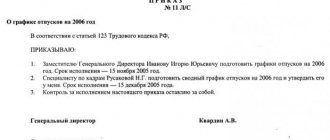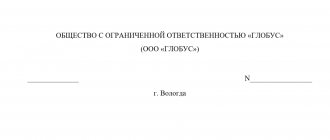Basics of KDP - what is important to know
Workers encountering this acronym for the first time may wonder what KDP recovery is. This term is used by personnel officers to refer to a process aimed at correcting errors and shortcomings made in the conduct of personnel records. The preparation of all personnel papers must occur in accordance with the norms and rules of the current labor legislation, but not all companies pay sufficient attention to this.
After we have figured out the KDP - what it is in personnel, we will consider situations when the restoration of personnel records management is necessary:
- the organization does not have a specialist in HR records management;
- an audit of the company's activities by regulatory authorities is coming;
- if labor disputes often arise with employees, etc.
If such phenomena occur at your enterprise, it is worth thinking about how to correct the situation and how to restore the control panel.
General basics of office management of an organization
Office work is the process of creating and circulating all documents of an organization. Including their reception, processing, control and execution. At an enterprise, this activity is carried out by a secretary, an office manager, or an entire department headed by a leading specialist - a document specialist.
The main stages of office work are:
- Creation or receipt of documents, including their registration.
- Monitoring the execution of the document, transferring it to the appropriate officials, signing, responding and other actions.
- Preparation of documents for operational or archival storage. In some cases, files and papers may be destroyed.
Record keeping at an enterprise can be organized in different ways, the most common types are:
- decentralized - documents are created, accepted and processed in each department individually. This is true for large enterprises with diverse activities;
- centralized - the organization has a special unit dedicated exclusively to working with documentation. This may be a secretariat, an office management department, or one employee performing these functions. Typical for small and medium-sized enterprises;
- mixed - includes a combination of the first two types.
No matter how the paperwork is organized, this must be reflected in the regulatory documents of the enterprise.
Special opinion
Evgeniy Poluboyarov
HR audit expert, co-founder
I would note two main risk factors for poor management of CDP in a company:
1. Scheduled and unscheduled inspections of the State Labor Inspectorate.
The total amount of administrative fines collected by the State Labor Inspectorate in Moscow for 9 months of 2020 from legal entities and officials increased by 13% compared to the same period in 2020 and amounted to 176 million 784 thousand rubles. (information taken from the website of the State Information Technology Department of the city of Moscow). In the regions, the figures are, of course, more modest, but also very significant. Thus, in the Saratov region for 11 months of 2020, the total amount of fines imposed amounted to 46 million rubles.
2. Labor disputes with employees.
The main materials when considering disputes between employees and employers in court are personnel documents. Illiterate hiring procedures and failure to comply with the procedures for imposing an administrative penalty or dismissal makes the company vulnerable in court and ends with the reinstatement of the employee, payment of forced downtime, moral damages and fines.
Office work and document flow in an enterprise is an organizational necessity
The financial success of the enterprise directly depends on how well the document flow process is organized. Managers should select competent personnel, regularly send secretaries for advanced training and monitor changes in legislation.
In any organization, office work is, in fact, the “circulatory system” of the enterprise. With the right approach, it functions smoothly, delivering the necessary papers to responsible officials, sending letters, and removing unnecessary documents for storage.
Any company manager understands that office work is a system that must operate clearly and competently. If necessary, various options for electronic assistants should be considered and staff trained to use these systems accordingly.
Maintaining KDP - what is it and what does it involve?
Drawing up work books and contracts is, of course, a very important part of the work of any HR employee, but personnel records management is not limited to just these moments. All documents that the personnel officer must have at hand can be divided into two main blocks.
The first group includes both legislative and by-laws that explain labor protection and labor law standards. All documents of this nature are binding.
The second group is documentation of a recommendatory nature: methodological recommendations on personnel records management and management work.
It is important for a personnel employee to know which documents are mandatory for execution at a particular enterprise, and which ones come into force only under certain circumstances. This will allow you to avoid negative experiences when communicating with personnel inspectors.
When creating personnel documentation, you should be guided by the following rules:
- internal documents (their appearance, the procedure for development and approval) can be convenient and understandable specifically for a given enterprise or organization;
- external documentation is drawn up according to generally accepted rules so that these documents have legal force;
- storage of personnel documentation is carried out taking into account the rules and requirements of the archival service.
What types of HR documents are there?
All personnel documentation can be divided into two groups:
Group 1: documents that regulate the employer’s relationship with each employee individually.
Group 2: documentation reflecting labor relations throughout the company.
The first group includes the following personnel documentation :
- employment order (T-1);
- contract with an employee (TD-1);
- work book (Resolution of the Government of the Russian Federation “On work books” dated April 16, 2003 No. 225);
- employee personal card (T-2);
- translation documents (T-5);
- order for registration of leave (T-6);
- dismissal order (T-8);
- order to send an employee on a business trip (T-9);
- travel certificate (T-10);
- service assignment (T-10A);
- administrative document indicating the promotion of an employee (T-11).
The second group includes:
- Vacation schedule (T-7).
- Staffing table (T-3).
- Order to dismiss several employees (T-8a).
- Order on secondment of workers (T-9a).
- Order on employee incentives (T-11A).
- Time sheet (T-12)
- A document on the basis of which control of the number of hours worked and calculation of salary is carried out (T-13).
- Journal of checks of military registration of citizens.
- Order on the organization of military registration.
- Internal regulations: collective agreement;
- regulations on labor protection;
- bonus regulations;
- inner order rules;
- regulations on business trips;
- provisions on trade secrets;
- wage regulations;
- regulations on the use of personal transport for business purposes;
- other.
On the storage of personnel documents, see the material “What are the storage periods for documents according to the nomenclature of cases?” .
Personnel records management as the basis for stable operation of an enterprise
Most large enterprises are actively engaged not only in general, but also in personnel records management. That is, a system that includes documents related to the personal and labor data of employees.
Personnel records management is characterized by much more stringent standardization. Most documents are prepared on standard forms. All wording and records must comply with the law - in particular, the Labor Code. In addition, the enterprise has its own regulations regulating working relationships with employees.
The organization of personnel records management is always carried out by a separate division of the enterprise. If the company is small, then this may be one employee, but in this case the corresponding responsibilities must be specified in his employment contract.
The names of the divisions can be very different:
- "Human Resources Department";
- "Personnel Service";
- "HR Managers";
- "HR department".
Instructions
Regardless of the size of the company and its shape, the manager should not neglect the presence of instructions for office work.
An instruction is not only a normative act that allows you to organize office work. What it is? This is an internal document of the company, which is approved by order of management and has no expiration date.
The main stages of the movement of documents are described here, a list of officials who have the right to sign a particular document is given, and samples of filling out and designing forms are given.
Basic Concepts
Each company, regardless of its status and number of employees, issues and processes a large number of documents in the course of its activities. All of them relate to organizational and administrative documents. The basic concepts in this matter include office management and document flow.
Office work is the type of activity that ensures the creation of official documents and also organizes work with them. In turn, document flow is understood as a type of activity that is aimed at organizing the movement of documents in a company from the moment they are created or received until the completion of work with them (sending to the addressee, filing in the archive).
Often, for office work, an organization allocates one or more employees who control the process.
No enterprise can exist independently of legislation. It regulates office work and document flow. Issues in these areas are resolved by secretaries, archivists and personnel department employees.
Record keeping is based on recording data through the creation of a paper or electronic act. In this regard, document flow appears, that is, the movement of a document from the moment of creation to its execution. Document flow can be divided into internal and external.
The internal circulation of documents is represented by the following stages:
- Development of a draft document.
- Coordination with management.
- Signing the document.
- Registration of the document: date and number (after the document is issued, it is considered accepted for execution).
- Bringing information to the addressee and control.
- Execution.
- Publication of the executed document.
- Destruction or archiving of expired papers.
External turnover involves the following stages:
- Receipt of the document to the company.
- Registration of received documentation (necessary for monitoring the execution of documents).
- Work with correspondence: familiarization, execution.
- Formatting a response if necessary.
- Archiving or destruction.
Regarding management, document flow is:
- ascending (from subordinate to superior);
- downward (from superiors to subordinates);
- horizontal (between subordinates).
Every movement of any document must be recorded in a special journal. This could be a logbook, a document card, an electronic journal, etc.
Knowledge of KDP
Rybalko Svetlana,
Head of HR Consulting Department
Coleman Services
The importance of legally competent personnel documentation is difficult to overestimate. Any personnel document is a recording of legally significant facts on paper. For example, an employment contract is a decision between two parties, reached by agreeing on the conditions under which the employee will perform his job function, and the employer will provide the employee with everything necessary for effective work and pay for his work.
Of course, any mistake by a personnel officer can lead to adverse consequences for the employer, but in this article we will focus on only two serious blocks of personnel work - local regulations and employment contracts, because errors in these documents lead to maximum risks.
When conducting an examination of personnel documentation for our clients, I, as a rule, recommend unifying personnel document flow and reducing the documents of the personnel documentation package to the necessary minimum - in this case, a balance will be struck between compliance with legal requirements and minimizing errors when creating capacious documents that will contain only essential information.
When creating local regulations, we, in an effort to preserve the structure of the document, fill it with “extra information.” Thus, in small companies, I often come across many local acts that duplicate each other: Collective Agreement, Internal Labor Regulations, Regulations on Remuneration, Regulations on Bonuses, Company Code, Regulations on Regime and Secrecy, etc. It would be good if a lawyer participated in the creation of these documents, but in practice it turns out that a personnel officer with little experience uses knowledge acquired on the Internet, and local acts created using the Internet are not only filled with unnecessary information, but contradict each other. Now let’s imagine: how much time does a personnel officer spend on the hiring procedure - after all, in accordance with Part 3 of Art. 68 of the Labor Code of the Russian Federation, before signing an employment contract, the employer is obliged to familiarize the employee, against signature, with all local regulations (LNA) directly related to the employee’s work activity.
The Labor Code of the Russian Federation clearly requires the employer to have only two local regulations: Internal Labor Regulations and Regulations regulating work with personal data of employees. If you carefully think through their structure, then these two documents can contain as sections all the necessary regulations (rules of remuneration, rewards and disciplinary sanctions, rules of corporate ethics and confidentiality, etc.), there will be no need to create other LNAs.
But, let's move on to specific mistakes made when creating LNA. This:
— lack of specific information about working hours and rest hours in this company. In the best case, a 5-day, 40-hour week with two days off and a meal break of no more than 60 minutes is prescribed. However, analyzing employment contracts with employees of this organization, I see the establishment of an irregular working day for almost 80% of employees - which is not reflected in any way in the LNA, although in accordance with Art. 101 of the Labor Code of the Russian Federation, the list of positions for workers with irregular working hours is established by a collective agreement, agreements or local regulations adopted taking into account the opinion of the representative body of workers. Considering the rhythm in which business operates, many companies do not set a specific lunch break time and prescribe a “floating lunch break regime,” which means that applying the legal norm to impose a disciplinary sanction in the absence of an employee for 4 hours in a row will be problematic ;
— lack of regulations for the payment of wages: how often wages are paid, what are their components, place and procedure for their payment, etc. Instead, outdated norms and terminology of the Labor Code of the Russian Federation (for example, advance payment and wages) may be used. In addition, it happens that a company uses various forms of remuneration (hourly or daily rate, official salaries), but the LNA does not contain information about this;
— in the presence of separate divisions in other regions, where the work, rest and remuneration regimes have their own peculiarities, but are not reflected in any way in the LNA (and often in employment contracts too), which reduces the level of guarantees for the organization’s employees in these regions compared to the Labor Code of the Russian Federation;
— errors in the staffing table. The staffing table is a document that reflects the diversity of positions and pay levels throughout the organization; it must also include separate units. At the same time, “salary variations” are categorically unacceptable; this will be interpreted as discrimination in the world of work (this is a serious violation of the law, which occurs in almost 90% of companies that have regional divisions);
— lack of information about wage indexation, although Article 134 of the Labor Code of the Russian Federation stipulates that employers carry out wage indexation in the manner established by local regulations;
— restriction of employee rights when establishing rules for working with confidential information. Employers, “getting carried away” by the issue, oblige employees to notify the employer of their intention to work part-time (otherwise the employee faces a number of administrative measures), which is a violation of Art. 282 Labor Code of the Russian Federation;
— consolidation of internal organizational norms in the LNA (for example, bypass sheets when dismissing an employee, obligations to comply with the dress code). These rules are not legal in nature and it is impossible to hold employees accountable for violating them. Moreover, delaying the work book when dismissing an employee who has not submitted a bypass sheet is a violation of the Labor Code of the Russian Federation and entails the payment of average earnings for the entire period of delay with the payment of fines;
— lack of necessary information when developing the Regulations on Personal Data: the list of officials with access to personal data and the procedure for processing data is not specified, the lack of an exhaustive list of documents related to personal data;
- violation of Art. 192 of the Labor Code of the Russian Federation, according to which the list of disciplinary sanctions is exhaustive and the application of any other penalty to violators of labor discipline (for example, deprivation of a bonus, reduction of the bonus percentage, postponement of vacation, reduction in the number of days of vacation for absenteeism, imposition of monetary fines and deprivation of any or benefits as punishment, etc.) is illegal.
This is far from complete information about the mistakes made when creating Local regulations. Within the framework of this article, I only wanted to identify the problem. There are several simple recommendations - when creating any personnel document, think about its content. Do not try to rewrite the provisions of the Labor Code of the Russian Federation, but use its wording. Describe the specifics of your company, do not include in the document conditions that are not typical for your company, which is called “for the future.”
Speaking about errors in the preparation of personnel documentation, one cannot help but consider such a document as the Employment Agreement, a copy of which is kept in the employee’s hands. Its importance is difficult to overestimate - an employment contract is a compass with which the employee checks throughout the entire period of employment with the employer and is sent with him to the labor inspectorate and to court.
One of the common mistakes is the lack of information in the employment contract about the components of wages - regional coefficients and bonuses to official salaries. Many companies have separate divisions in the regions, but since the head office is located, for example, in Moscow, HR officers use a single employment contract template, without taking into account regional characteristics. The employer and employee, when agreeing on the terms of the employment contract, enter into a “gentleman’s” agreement that everything will be included in the official salary, and as a result, the employment contract does not reflect regional allowances, coefficients and additional leaves. When an audit comes to the organization, it turns out that the rights of employees have been violated and the employer has to apply a coefficient to the salary that is specified in the employment contract and make payments to all regional employees for the entire period of the employment relationship with them, and even with the application of a fine in accordance with Art. . 236 Labor Code of the Russian Federation.
Another common mistake is also related to the use of one template for all categories of personnel. If an organization establishes different working hours, then it is logical to assume that the payment options will be different. In this case, by using a single employment contract template, the personnel officer exposes the employer to serious risks. After all, if a summarized accounting of working time is established for an employee (for example, working on a rotational basis), then it is necessary to provide not only an accounting period, but possibly also a work schedule, a method of payment and additional compensation for working on a rotational basis, the provision of additional annual leave, etc.
The advice is similar to that given above, in a situation with local regulations, you need to figure out what categories of employees there are in the organization, how many templates of employment contracts need to be developed and think through their content. A change in working hours, as a rule, entails a change in the method of payment - this means that it is necessary to make additions to the sections “Working hours, rest time”, “Wages” in the contract template developed by lawyers. HR officers often complain that it is very difficult to convince an employer (even referring to the law) to increase the amount under the contract, but who is talking about increasing the final amount? How to write down wages in an employment contract is the skill and professionalism of a personnel officer. Of course, you shouldn’t immerse directors in the technical details of how you maintain a balance between legal requirements and the size of the organization’s budget.
Personnel documentation is very important. It establishes facts that are legally significant for both the employee and the employer. You should document labor relations very carefully, because success in resolving labor disputes depends on the quality of execution of these documents. You should not save time when creating personnel documents, since a carefully developed document, on which a little more time was spent, will save your company money.
kdpwhat is kdpkdpkdp courses what is it
Are all companies required to keep military records?
According to sub. 6 clause 1 art. 8 of the Federal Law “On Defense” dated May 31, 1996 No. 61-FZ, all companies are required to maintain military records. The main purpose of this accounting is the collection, storage and transmission to the military registration and enlistment office of information about military personnel.
Important! Individual entrepreneurs are not required to keep military records (Clause 6, Article 1 of the Law “On Military Duty and Military Service” dated March 28, 1998 No. 53-FZ).
The specialist responsible for military registration is appointed by the head of the company. To maintain military records, either a new employee or an existing employee can be involved, with whom a contract for combining positions is drawn up. The number of specialists maintaining this record depends on the number of employees liable for military service (clause 12 of the Decree of the Government of the Russian Federation “On approval of the Regulations on military registration” dated November 27, 2006 No. 719).
During military registration, the following documents are important:
- order on the organization of military registration;
- military registration audit log;
- personal card T-2.
On the procedure for entering information about a military ID in T-2, see the material “Unified Form No. T-2 - form and sample filling” .
Verification of military registration is carried out every three years for a population of up to 500 people. If the staff is greater than the specified number, then control should be carried out once a year (clause 3 of Appendix 1 of the Methodological Recommendations for maintaining military records in organizations).
Responsibility for violation of the procedure for maintaining military records is provided for in Art. 21.1–21.4 Code of Administrative Offenses of the Russian Federation. For example, if the employer fails to submit a list of those liable for military service, liability arises in the form of a fine in the amount of 300–1,000 rubles, and if the employer did not inform the employee about his call to the military registration and enlistment office – 500–1,000 rubles.










